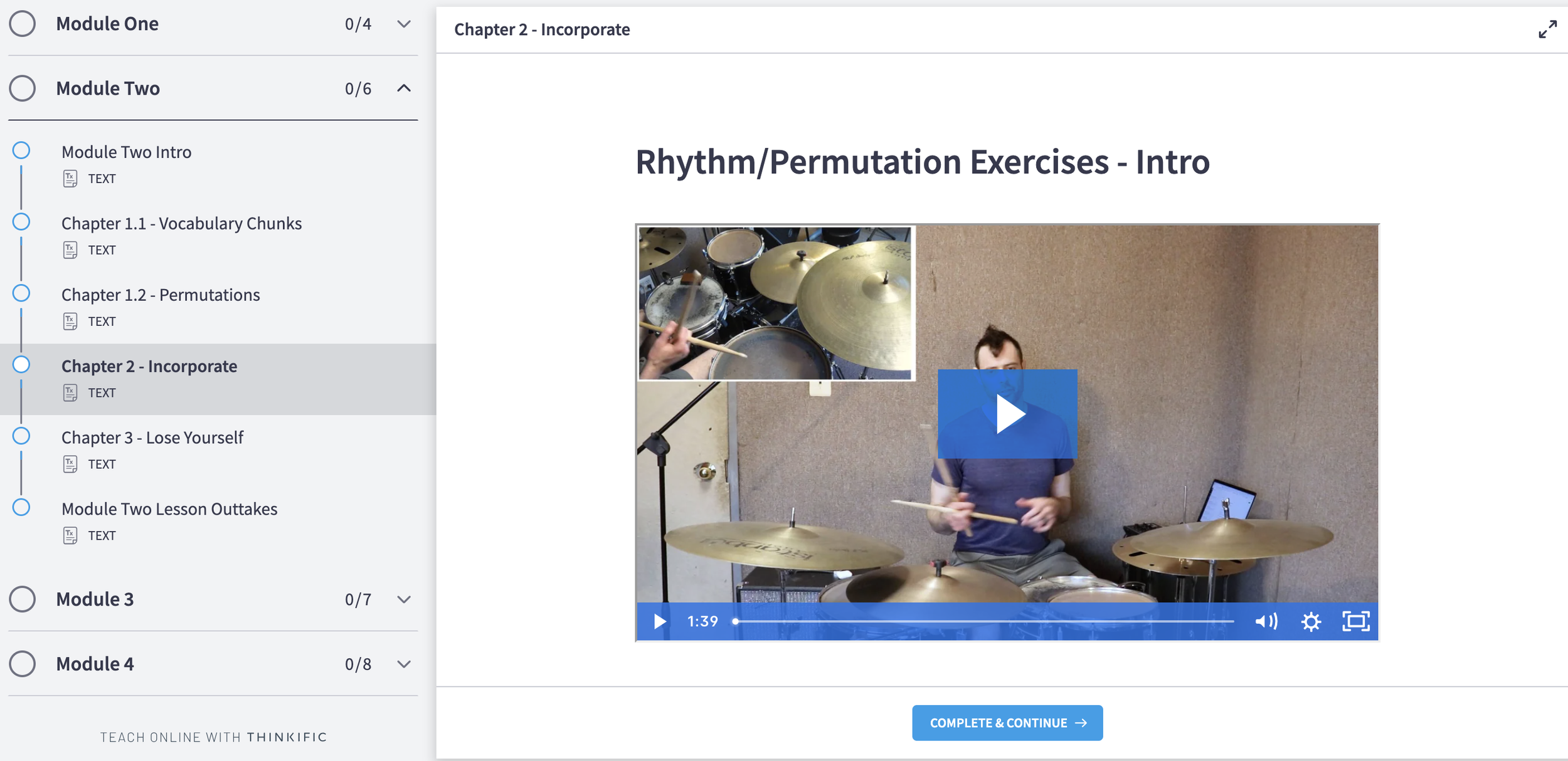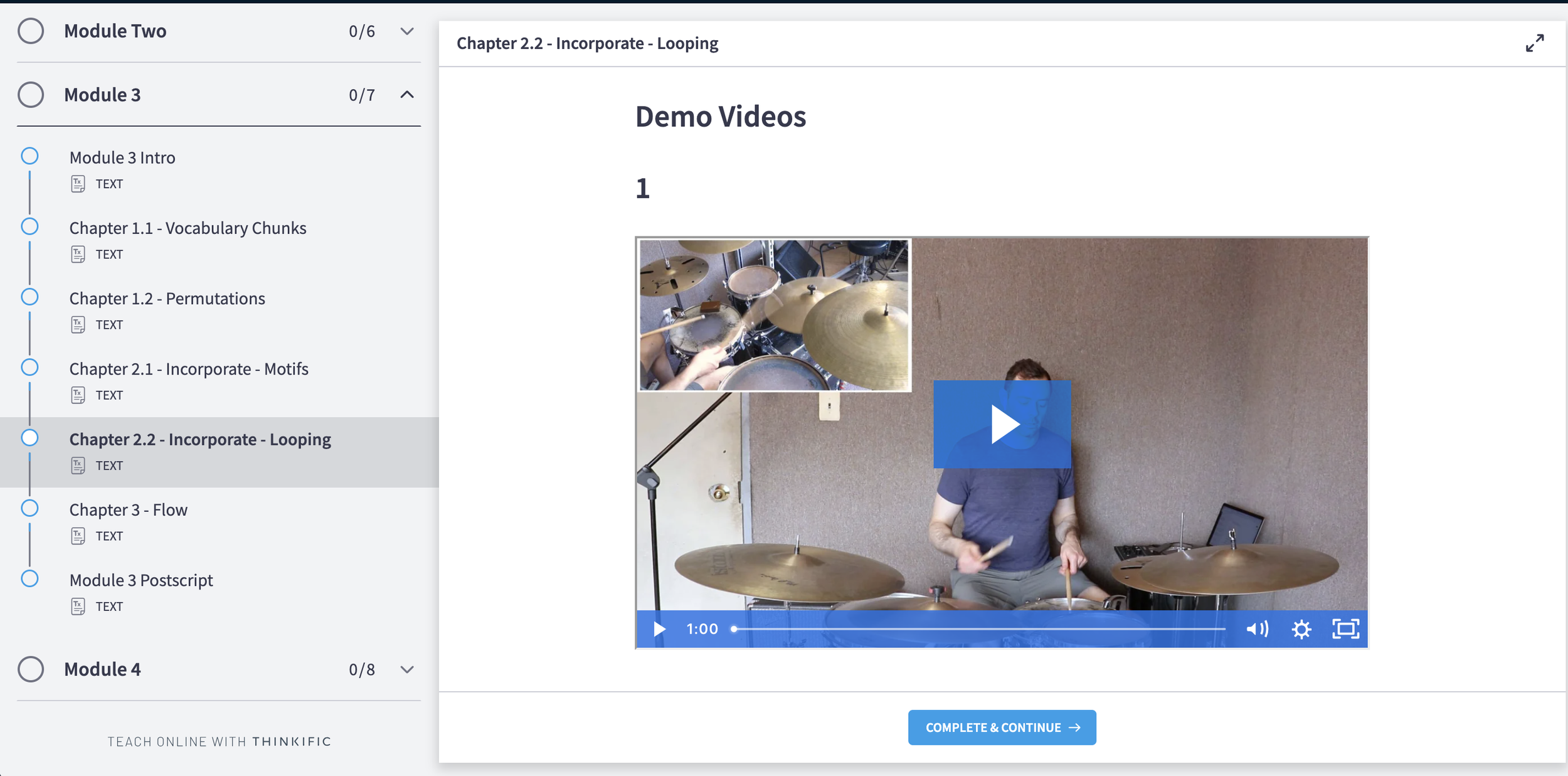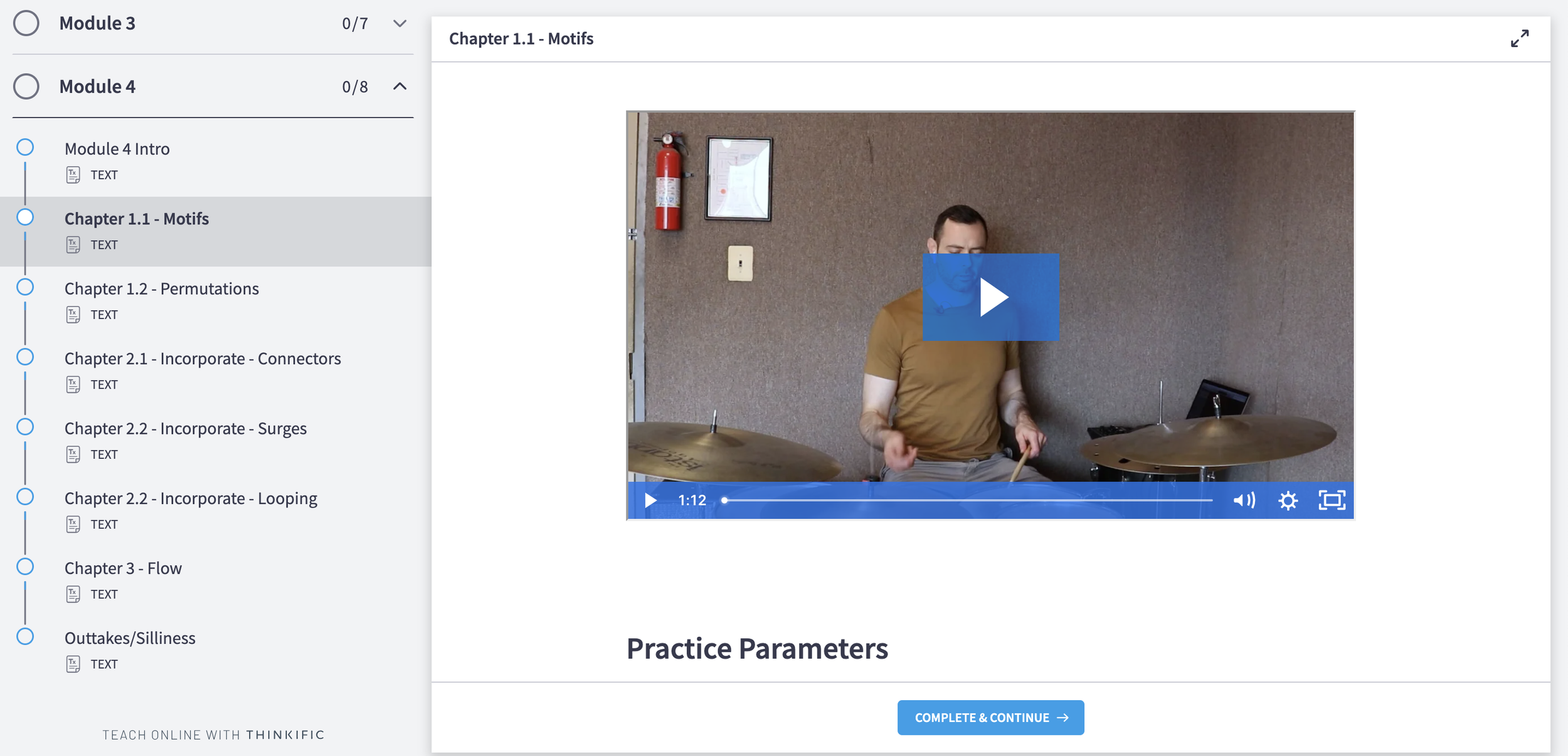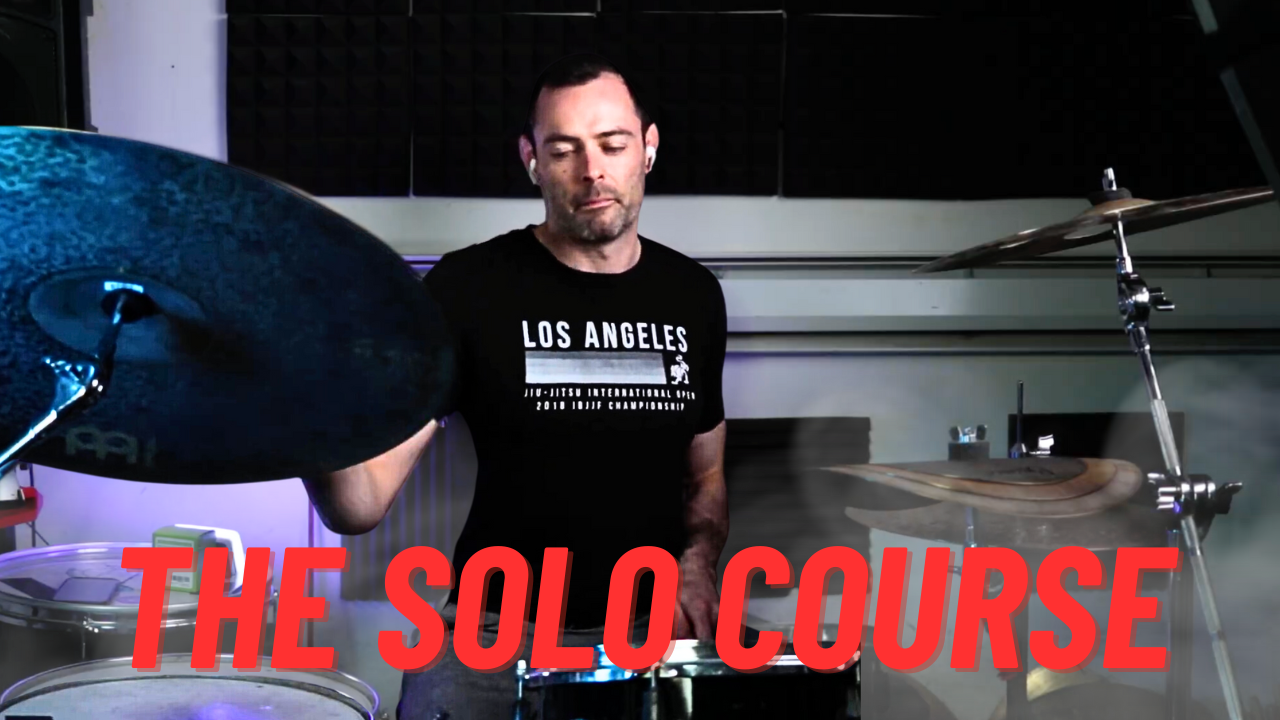express yourself clearly, cleanly, and authentically on the drums - in 3 months or less
Even if you think “drum solos” are self-indulgent, you’re a “groove player”, or you’ve tried “everything else”
limited time bonus - be one of the first 20 people to enroll*, and get a free video evaluation from nate - up to 15 minutes of any video you want me to look at.
*Deadline is Thursday, April 4
Slots are still available
what if you could express any musical thought on the drums without tripping over your words?
The feeling of complete freedom when you play.
Instead of thinking, you’re just “jamming along with yourself”.
Ideas occur to you, and they just come out on the drum kit.
Clearly, with good sounds, time, phrasing, and dynamics.
And without disrupting the music.
And as long as we’re wishing for stuff, I’d like a pony.
Because, if you’re anything like I was, the reality is a bit different.
Maybe you call yourself “a groove player”, but deep-down, you know that if you deviate from snare and hi hats, things get…dicey.
Forget about “taking a solo”.
Say instead you wanted to switch to a “tom groove”, like Matt Cameron.
Or start playing 16th notes on the hats to add some texture.
Or throw in a tasty fill to cue a new section.
As soon as we deviate from the safety of “boom chick”, our heart rate goes up.
Now we’re worried the time’s going to migrate. Or that we’ll lose the band and incur dirty looks.
Fundamentally, we’re just worried we won’t pull it off.
“I’m a groove player”
This guy looked like a “groove player” to me. If he looks like you, I’m sorry. To be fair, I probably look like a “groove player” too.
Eventually, we learn which areas of the drum kit are “safe”.
Keeping to the hats, not changing things up too much. Sometimes even avoiding rim shots, because those are “handle with care”.
And sometimes…
Sometimes…
We appropriate the very true, very valid sentiment that “drum solos” can be self-indulgent and disruptive to the music…
…and that groove is the most important element for a song…
…to say “I’m a groove player.”
I’ve talked to so many drummers who tell me “they’re groove players”/”they’re not interested in drum solos”. Then, after I help them through a couple of break-throughs, and they start getting more confidence in their voice, their tune changes.
“I feel like I can play over the kit now. I feel like I can truly express myself.”
Before we talk about why, and how, let’s dispense with the myth of drum solos.
Just trust me bro
“drum solos” are a lie
Let’s say you’re with me so far.
You’re nodding along, thinking “that’s me”.
What comes to mind when you think “drum solos”?
Bad, unmusical, self-indulgent playing. Disruptive. Too loud. About the drummer, not the song. Right?
I see it all the time in my youtube comments. The first issue is when people who don’t like drum solos picture drum solos, they picture bad drum solos.
The other issue is they think “drum solos” always necessarily mean playing selfishly, and “showing off”, rather than playing for the song.
the reframe
But what if I told you “drum solos” are just expressing yourself on the instrument.
I like to think of playing drums like speaking a language.
To illustrate what I mean, imagine you couldn't use the past tense in English, and you only knew a few words.
Even basic communication would be difficult.
Now imagine if someone asked if you wanted to learn more words and grammar, and you said "no - that's for SHOW OFFs."
Being a better communicator does not mean you need to be a great orator, or an actor, or give a Ted Talk, or stand on a castle wall motivating troops...in some old-timey setting I'm imagining for some reason. (Maybe because of Napoleon.)
Instead, imagine having a musical thought - one that enhances the music - and being able to follow it, without fear of messing up.
Imagine knowing your ideas would come out clearly and cleanly. Just like they do when you speak.
Being able to walk into a room and say “hi, my name is Nate, and I’d like a cabbage” doesn’t require mean you have to rattle off syllables like an auctioneer or a battle rapper.
It just means that if you have a thought, you can express it clearly.
That’s it.
We hope everything we practice will “just come out” in our playing, but that’s not always the case.
so why is it so hard?
That still doesn’t explain why learning those words, phrases, and sentences - to borrow my friend and sometime co-coach Jacob Evans’ parlance - is easy.
If it were, you probably wouldn’t be here, reading this page.
The problem with “speaking clearly” on the drum kit is that most of the existing educational material emphasizes only one thing.
Say it with me.
“Vocabulary”
Rudiments. Licks. Patterns. Combos.
Whether it’s drum books, instructionals, or social media, you’ll never fear for views or likes making a video on “this cool linear lick that goes RKKLR.”
And that stuff is important. But imagine you learned a language by memorizing words out of a book, and never practiced using them in sentences. You’d end up with a lot of useless vocabulary in your head. Then, when it came time to speak, you’d clam up.
(Trust me - I’ve experienced this both with the drums and with language learning.)
All that vocabulary is useless if you can’t access it in the moment.
a different kind of drum course
When I first set out to create a course that would help drummers express themselves cleanly, clearly, and authentically on the drums, I knew I’d have to borrow a concept from language learning: application practice.
If you’ve ever studied a foreign language, good books will give you some vocabulary, some concepts, and some example sentences to memorize.
But they don’t stop there.
“Make sentences about the people in these photos, using the grammatic construction we just learned,” reads an instruction in one of my Spanish texts.
So why don’t we do that in drums?*
*Well, only recently some drummers, like J.P. Bouvet, and Benny Greb, are starting to incorporate that concept.
What if we approached drums like language learning?
And so am I!
I like to say The Solo Course is the first course that incorporated that sort of “language practice” in a formal way. I may be off by a few months.
But there’s a third thing hardly anybody was teaching: flow practice.
Just “letting go” and “turning off your brain”, and letting the musical thoughts come without curation. As you would hope to do when “playing in the moment” in a real musical situation.
When I started sharing these concepts with students, I realized it wasn’t any individual concept that made the system work. It was the special combination of all 3 things, in a specific sequence.
The “magic” of “seasonal learning”
Getting better at expressing original phrases on the drums is a 3-part process:
First we learn the vocabulary
Next we “drill” with it, so it becomes ingrained, and we can recall it in the moment without thinking
Finally, we practice “shutting off” our “judging mind”, and simulate flow situations
And we can keep repeating these steps again-and-again, like the seasons.
introducing the solo course
Nate taking an unstructured solo
The first and only affordable, self-directed course for drummers who want to express themselves clearly, cleanly, and authentically on the drums, which uses “seasonal learning” - the 3-part learning process I described above.
I developed the Solo Course with the help of students, who sent me videos of their playing, and real practice routines.
Over the next several months we experimented with the most effective exercises to help them gain new vocabulary, integrate it into their instinctive playing, then “let go” and just express themselves on the drums.
THE “seasons” OF integrating new vocabulary
“Season 1” - Vocabulary
That’s the one everybody’s familiar with. Your rudiments, and licks.
But in the Solo Course, I’ll show you some “special” things I discovered, which helped “fast track” me to having more idiomatic, “drumistic” vocabulary.
“Season 2” - Structured Assimilation
That’s the drum equivalent of those “make sentences out of these words and concepts” exercises.
In the Solo Course, that often looks like making combinations of idioms you’ve just learned, or taking a single idiom, and “using it in a sentence” when you’re otherwise improvising.
Then...
“Season 3” - Flow
This is the part of the course where we shut off our “left brains”, and practice playing without judgment.
To do this, we use simulations with constraints. For instance “Improvise with quarters and 8ths, no rimshots, using the snare, kick drum, and floor tom”.
MY PROMISE WITH THE solo COURSE
And this “seasonal practice” goes through that 3-part cycle four complete times within the course. First with basic vocabulary, then with more and more advanced phrases and idioms, so that, by the end of the course, you’ll be expressing yourself with a lot more fluency, and drawing effortlessly on a much bigger reservoir of ideas.
And that's my promise with this course. If you complete the course material, you will be able express yourself clearly, cleanly, and authentically, through a range of scenarios, in just 3 months.
And you won’t feel restricted to just the hats when you sit down to play.
You can still be a “groove player” as much as you want…
…but when the time comes to switch to the toms to give that groove a different flavor…
…or throw in a tasty fill at the most intense part of the song…
…you won’t have to fear anything will fall “off the rails”.
Now, let’s look at how we’ll accomplish this…
INSIDE THE solo COURSE
The Solo Course has over 96 separate videos, organized into 4 modules that grab you by the hand and take you step-by-step through the key insights and exercises to fine-tune your groove instincts.
It sequences the learning so that you're only working on what you can handle at the time, then builds little-by-little on the skills you acquire throughout.
HOW THE COURSE IS ORGANIZED
Detailed Explanations - For every skill or concept we introduce, there's a video talking you through it...
...then exercise pages with videos of me demonstrating the exercises, and transcriptions you can either view on the page - which I recommend - or download to your device or to print.Application Practice - One we’ve introduced the concept, you’ll have practice prompts that show you exactly what to practice to absorb the concepts - whether that’s learning an idiom verbatim, or “applying” that idiom in a limited-improvisation environment.
Learn on-Demand - And this course is self-paced, and on-demand, which means you can choose your own pace through the material.
watch 2 sample videos from the program - the first is from module 2 - on incorporating vocabulary
here’s the second sample video - from module 3 - this covers “trading”
TABLE OF CONTENTS - HERE’S EVERYTHING THE COURSE COVERS
Module 1 - concepts
Module One Intro - Watch This First!
Chapter One - Here's What You Told Me
Chapter 2 - Here's The System
A Guided Tour Through The System
Module 2 - first "cycle through the seasons” - basic
Module 2 Intro
Chapter 1.1 - Vocabulary Chunks
Chapter 1.2 - Permutations
Chapter 2 - Incorporate
Chapter 3 - Lose Yourself
Module Two Lesson Outtakes
Module 3 - second “cycle through the seasons” - intermediate
Module 3 Intro
Chapter 1.1 - Vocabulary Chunks
Chapter 1.2 - Permutations
Chapter 2.1 - Incorporate - Motifs
Chapter 2.2 - Incorporate - Looping
Chapter 3 - Flow
Module 3 Postscript
Module 4 - third “cycle through the seasons” - advanced
Module 4 Intro
Chapter 1.1 - Motifs
Chapter 1.2 - Permutations
Chapter 2.1 - Incorporate - Connectors
Chapter 2.2 - Incorporate - Surges
Chapter 2.2 - Incorporate - Looping
Chapter 3 - Flow
Outtakes/Silliness
WHAT’S THE INVESTMENT?
One of the many intro videos from The Solo Course
Since last year, almost 30 drummers have invested over $2000 to join programs like my group coaching, which is structured to be 12 weeks long, and includes personal coaching from me. And that’s a great choice for a drummer who wants personalized attention. But I wanted to build something accessible to way more drummers.
I wanted the Solo Course to be so affordable it’s a no-brainer.
That’s why I made a self-directed course you can do at your own pace, so I’m able to offer it for a very low price:
The Solo Course is just $197 for lifetime access.
But this is not just your average “here are a bunch of exercises; good luck” course, where I leave you to your own devices.
Instead, I wanted the course to feel like a “virtual concierge” - like I’m taking you by the hand and walking you through the material.
That’s why the Solo Course has a whole extra layer of intros and explainers.
For every single concept, I made a video telling why it’s important, how to practice it, and how it fits in the overall framework of the course.
So you can enroll with confidence that I’ve made it super easy to follow, and very hard to get lost. In fact, I’ll guarantee it.
MY GUARANTEE
I’m very proud of this course, and I’ve gotten great feedback on it.
That’s why I’m happy to guarantee it for 90 days.
Which means you can try the groove course risk free.
If it’s not the best self-directed resource for improving your pocket you’ve ever tried, just write us an email at nate@8020drummer.com, and we’ll refund you, no-questions asked.
READY TO SEE WHAT THE Solo COURSE CAN DO FOR YOU?
This course is for you if…
You’re tired of feeling “restricted to the snare and hats”, and want to inject more creativity and variation to your playing.
You want to speak in complete, cogent musical sentences, and know what what you play is going to “come out right”.
You want to “take the leap” and explore expanding your options for expressing yourself on the drum kit, but do so by developing your own authentic voice.
imagine yourself in this course
Over 96 separate videos, organized into 4 modules that grab you by the hand and take you step-by-step through the key insights and exercises to fine-tune your groove instincts.
Sequenced learning, so that you're only working on what you can handle at the time, then builds little-by-little on the skills you acquire throughout.
Detailed Explanations - For every skill or concept we introduce, there's a video talking you through it...
...then exercise pages with videos of me demonstrating the exercises, and transcriptions you can either view on the page - which I recommend - or download to your device or to print.
Learn on-Demand - And this course is self-paced, and on-demand, which means you can choose your own pace through the material.
If you’re ready to arm yourself with new tools, and start feeling confident every time you sit down to play, I invite you to join now, risk-free.













